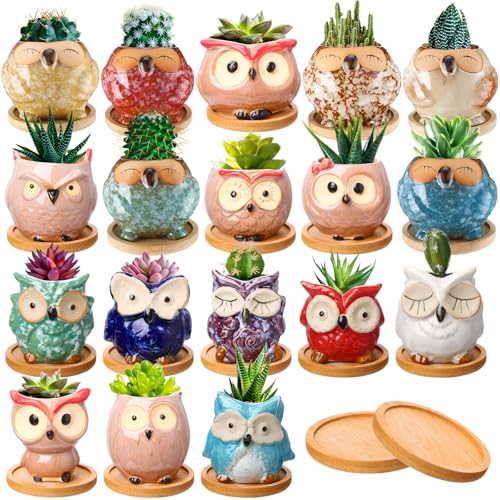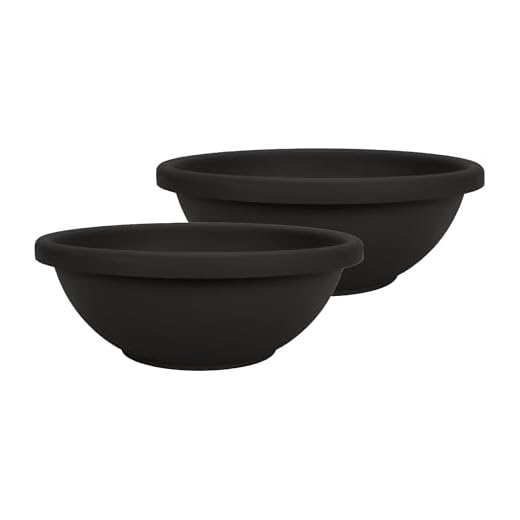




Bonsai pots are known for their unique design and aesthetic appeal. They are small, shallow containers that are specifically designed to cultivate and showcase bonsai trees. However, their suitability for other types of plants, such as succulents, is often questioned.
Succulents, with their ability to store water in their thick, fleshy leaves and stems, have gained popularity as indoor plants due to their low maintenance requirements and striking appearance. As such, many succulent enthusiasts wonder whether bonsai pots can be an ideal choice for growing succulents.
While the answer to this question may vary depending on individual preferences and specific requirements, there are several factors to consider when deciding whether bonsai pots are suitable for succulents. First and foremost, it is essential to understand the unique needs of succulents and how they differ from those of bonsai trees.
The Benefits of Using Bonsai Pots for Succulents
Bonsai pots are not only aesthetically pleasing, but they also offer several benefits for growing succulents. Succulents are known for their ability to store water in their leaves, stems, and roots, making them excellent choices for planting in bonsai pots.
Proper Drainage
One of the key advantages of using bonsai pots for succulents is their excellent drainage. Bonsai pots typically have multiple drainage holes at the bottom, allowing excess water to escape freely. This helps prevent waterlogged soil, which can be detrimental to the health of succulents.
The porous nature of bonsai pot materials, such as ceramic or terra cotta, also aids in drainage by promoting air circulation and preventing root rot. This ensures that the succulents’ roots do not become soggy and are able to breathe properly.
Controlled Growth
Another benefit of using bonsai pots for succulents is the controlled growth they provide. Bonsai pots are generally shallow and small in size, which limits the amount of space available for the succulent’s roots to grow. This encourages the succulent to grow slowly and remain compact.
The limited space also helps the succulent develop a well-developed root system that supports the plant’s overall growth. By keeping the roots contained, bonsai pots help prevent overgrowth and promote healthier, more manageable succulents.
Enhanced Visual Appeal
Bonsai pots are renowned for their aesthetic appeal and can enhance the beauty of your succulents. Their unique shapes, colors, and textures can complement the natural beauty of succulents and create a visually appealing display. The small size of bonsai pots also makes them ideal for displaying multiple succulents together.
Additionally, bonsai pots can be easily customized and decorated to suit your personal style and preferences. You can choose to paint or glaze them in different colors, add decorative stones or moss, or even incorporate traditional bonsai techniques.
In conclusion, bonsai pots offer several benefits for growing succulents. They provide proper drainage, promote controlled growth, and enhance the visual appeal of your succulent collection. Consider using bonsai pots to create a stunning and healthy display of your favorite succulents.
Proper Drainage
When it comes to succulents, proper drainage is key for their health and overall well-being. Unlike other plants, succulents have specialized water storage tissues in their leaves, stems, or roots that allow them to survive in arid conditions. However, these tissues are highly susceptible to rotting if they are constantly exposed to excess moisture.
Using bonsai pots for succulents can be a great choice as long as they have proper drainage holes. Bonsai pots are typically shallow and wide, which helps in preventing waterlogged soil and allows excess water to drain out quickly.
When selecting a bonsai pot for your succulents, make sure it has multiple drainage holes at the bottom to ensure proper water flow. These holes prevent water from pooling at the base of the pot and damaging the roots.
It is also helpful to add a layer of coarse gravel or small stones at the bottom of the pot before adding the soil. This layer acts as an additional drainage system by creating air pockets and preventing the soil from becoming compacted. This way, water can flow freely through the soil and out of the drainage holes.
Remember to water your succulents sparingly and allow the soil to dry out completely between waterings. Overwatering is one of the most common causes of succulent rot, so it’s important to err on the side of underwatering rather than overwatering.
Overall, bonsai pots can be a suitable option for growing succulents as long as they provide proper drainage. With the right pot and watering technique, your succulents can thrive and showcase their unique beauty in a bonsai pot.
Aesthetic Appeal
Bonsai pots add a unique and artistic touch to any succulent display. With their intricate designs and elegant proportions, bonsai pots can enhance the overall aesthetic appeal of your succulents. These pots are often crafted from high-quality materials such as ceramics, clay, or porcelain, which further adds to their visual charm.
Since succulents come in a wide array of shapes, sizes, and colors, the variety of bonsai pots available can complement their natural beauty. Whether you prefer a traditional, rustic look or a modern, sleek aesthetic, you can find a bonsai pot that suits your personal style.
Furthermore, the small size of bonsai pots is perfect for succulents, as it allows these plants to be displayed in compact and visually pleasing arrangements. The limited space in bonsai pots encourages succulents to grow in a more restrained and compact manner, which can enhance their beauty and make them appear more delicate and refined.
Overall, bonsai pots not only provide a practical home for your succulents but also add an appealing and artistic touch to your indoor or outdoor space.
Controlling Growth
Controlling the growth of succulents is an important aspect of bonsai cultivation. Bonsai pots are designed to restrict the root growth of plants, which can be beneficial for succulents.
When placed in a small bonsai pot, succulents are forced to grow slowly and have limited space for root development. This can lead to a more compact and aesthetically pleasing plant. However, it is important to note that succulents have different growth habits and requirements compared to traditional bonsai trees.
Here are some key points to consider when controlling the growth of succulents in bonsai pots:
- Choose the right pot size: Select a bonsai pot that is appropriate for the size of your succulent. If the pot is too small, it can restrict root growth too much and cause the plant to become root-bound. On the other hand, a pot that is too large may not provide enough restriction to control growth.
- Use well-draining soil: Succulents require a well-draining soil mix to prevent root rot. Bonsai soil mixes that are specifically formulated for succulents can be used to ensure proper drainage.
- Prune regularly: Trimming and pruning succulents can help control their growth and maintain their desired shape. Remove any overgrown or damaged leaves, branches, or roots to encourage healthy growth.
- Control water and fertilizer: Succulents are adapted to survive in arid environments and do not require frequent watering. Overwatering can lead to root rot and other issues. Similarly, avoid over-fertilizing as it can cause excessive growth and weaken the plant.
By properly controlling the growth of succulents in bonsai pots, you can create beautiful and healthy miniature plants that showcase their unique characteristics.
Improved Air Circulation
Bonsai pots are generally made with drainage holes and a porous material, which allows for improved air circulation compared to traditional clay pots. This is especially beneficial for succulents, as they thrive in well-draining soil and require good ventilation to prevent root rot.
The small size and shallow depth of bonsai pots also help to promote air circulation around the succulent’s roots. The shallow roots are easily exposed to oxygen, allowing them to breathe and absorb nutrients more efficiently. In addition, the restricted space in bonsai pots limits the growth of the succulent’s roots, preventing them from becoming overcrowded or compacted.
Improved air circulation not only benefits the roots of succulents but also helps to prevent moisture build-up on the leaves and stems. Succulents are adapted to arid environments and have thick, fleshy leaves that store water. However, excessive moisture can lead to rot and fungal diseases. The well-ventilated environment provided by bonsai pots helps to prevent these issues by allowing excess moisture to evaporate quickly.
| Benefits of Improved Air Circulation in Bonsai Pots for Succulents: |
|---|
| 1. Prevents root rot |
| 2. Promotes efficient nutrient absorption |
| 3. Limits the growth of roots |
| 4. Prevents moisture build-up on leaves and stems |
| 5. Helps prevent rot and fungal diseases |
Portability and Versatility
Bonsai pots offer a great solution for succulent enthusiasts who want to display their plants in a portable and versatile way.
One of the main advantages of using bonsai pots for succulents is their portability. Bonsai pots are typically small and lightweight, making them easy to move around. This means you can easily rearrange your succulents and create new arrangements whenever you like. Whether you want to display your succulents indoors or outdoors, bonsai pots allow you to easily move them around and find the perfect spot for your plants.
Bonsai pots are also highly versatile. They come in various shapes, sizes, and designs, allowing you to choose the perfect pot to match your succulents and your personal style. Whether you prefer a traditional terracotta pot or a modern ceramic pot, there is a bonsai pot that will suit your taste. You can also choose pots with different colors or textures to add an extra touch of style to your succulent collection.
Indoor and Outdoor Use
Bonsai pots are suitable for both indoor and outdoor use, giving you the flexibility to display your succulents wherever you prefer. If you want to bring a touch of nature into your living room or office, you can place your bonsai pots with succulents on a windowsill or a side table. On the other hand, if you have a garden or a balcony, you can use bonsai pots to create a beautiful display of succulents in your outdoor space.
Arrangement Options
With bonsai pots, you have the freedom to create different arrangements with your succulents. You can choose to display a single succulent in a pot as a focal point, or you can create a mini succulent garden by planting multiple succulents in one pot. You can also mix different types of succulents with varying colors and textures to create an eye-catching arrangement. The possibilities are endless when it comes to arranging succulents in bonsai pots.






